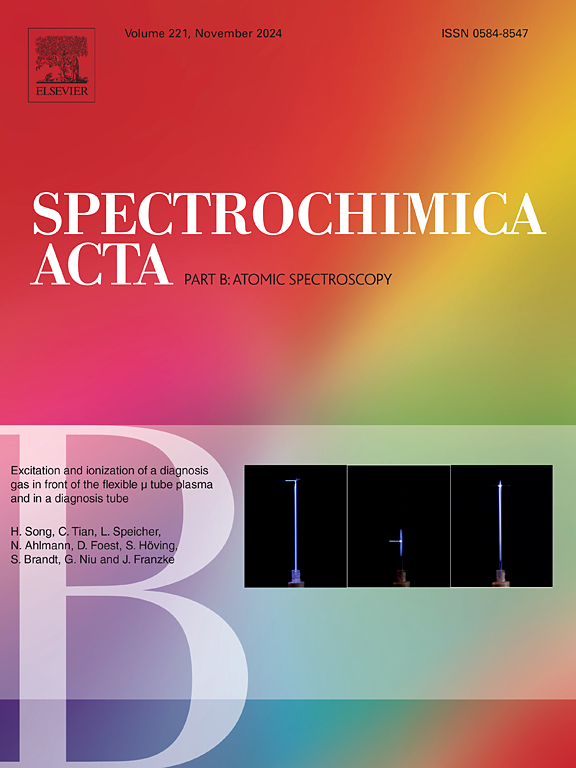Characterization of the self-reversal phenomenon of Ag resonant lines in laser-induced breakdown spectroscopy experiments
IF 3.8
2区 化学
Q1 SPECTROSCOPY
引用次数: 0
Abstract
In this work, we analyzed the phenomenon of self-reversal (SR) of spectral lines in Laser-Induced Breakdown Spectroscopy (LIBS) spectra through the study of the temporal evolution of self-reversed emission lines in neutral and ionized silver, using different laser energies and lens-to-target distances.
In these experiments, the characteristic dip of self-reversed lines corresponding to resonant transitions begins to form on the bremsstrahlung continuum within 20 ns after the laser-induced breakdown. The dip generated in the initial moments presents an inverted Lorentzian shape and, at later times, gradually acquires a Gaussian profile.
Additionally, we found that the self-reversal phenomenon in silver can occur in all transitions whose lower levels are below 6 eV and whose transition probabilities exceed 108 s−1. The SR depends weakly on the laser pulse energy but is strongly influenced by the lens-to-target distance. It is possible to minimize the effect by adjusting this distance. The formation of craters on the target also favors the appearance of self-reversal.
We propose a model to explain all the observed characteristics of the self-reversal phenomenon in this work, based on the interaction of Ag atoms and ions ejected by the plasma with the shock wave generated during the breakdown process.

激光诱导击穿光谱实验中银共振线自反转现象的表征
在本文中,我们通过研究中性银和电离银的自反转发射线的时间演变,分析了激光诱导击穿光谱(LIBS)中谱线的自反转(SR)现象,使用不同的激光能量和透镜到目标的距离。在这些实验中,在激光诱导击穿后的20ns内,轫致辐射连续体上开始形成与共振跃迁相对应的自反转线的特征倾斜。在初始时刻产生的倾角呈现倒洛伦兹形状,随后逐渐获得高斯分布。此外,我们发现银的自反转现象可以发生在所有低能级低于6 eV且跃迁概率大于108 s−1的跃迁中。SR受激光脉冲能量的影响较小,而受透镜到目标距离的影响较大。可以通过调整这个距离来减小影响。目标上陨石坑的形成也有利于自我逆转的出现。基于等离子体喷射出的银原子和离子与击穿过程中产生的激波的相互作用,我们提出了一个模型来解释本工作中观察到的所有自反转现象的特征。
本文章由计算机程序翻译,如有差异,请以英文原文为准。
求助全文
约1分钟内获得全文
求助全文
来源期刊
CiteScore
6.10
自引率
12.10%
发文量
173
审稿时长
81 days
期刊介绍:
Spectrochimica Acta Part B: Atomic Spectroscopy, is intended for the rapid publication of both original work and reviews in the following fields:
Atomic Emission (AES), Atomic Absorption (AAS) and Atomic Fluorescence (AFS) spectroscopy;
Mass Spectrometry (MS) for inorganic analysis covering Spark Source (SS-MS), Inductively Coupled Plasma (ICP-MS), Glow Discharge (GD-MS), and Secondary Ion Mass Spectrometry (SIMS).
Laser induced atomic spectroscopy for inorganic analysis, including non-linear optical laser spectroscopy, covering Laser Enhanced Ionization (LEI), Laser Induced Fluorescence (LIF), Resonance Ionization Spectroscopy (RIS) and Resonance Ionization Mass Spectrometry (RIMS); Laser Induced Breakdown Spectroscopy (LIBS); Cavity Ringdown Spectroscopy (CRDS), Laser Ablation Inductively Coupled Plasma Atomic Emission Spectroscopy (LA-ICP-AES) and Laser Ablation Inductively Coupled Plasma Mass Spectrometry (LA-ICP-MS).
X-ray spectrometry, X-ray Optics and Microanalysis, including X-ray fluorescence spectrometry (XRF) and related techniques, in particular Total-reflection X-ray Fluorescence Spectrometry (TXRF), and Synchrotron Radiation-excited Total reflection XRF (SR-TXRF).
Manuscripts dealing with (i) fundamentals, (ii) methodology development, (iii)instrumentation, and (iv) applications, can be submitted for publication.

 求助内容:
求助内容: 应助结果提醒方式:
应助结果提醒方式:


